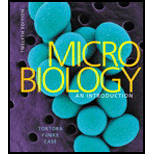
To write:
The complement destruction of the pathogenic organisms.
Given:
“Successful
Introduction:
The complement system consists of thirty heat-labile proteins from plasma, which involves the opsonization of pathogens for assisting the immune responses of the host. The complement proteins are protease in nature, which helps to cleave the antigens to neutralize the infectious substances. It is a cascade or a series of proteins (from C1 to C9 and some proteins are indicated as lower cases a and b) that commence at the time of infection which is termed as complement activation.
The proteins from the complement system play a major role in the destruction of microbes by inflammation, cytolysis and opsonization. It is an essential barrier that protects the host tissue from the invading organisms.
Want to see the full answer?
Check out a sample textbook solution
Chapter 16 Solutions
Microbiology: An Introduction
- When antibody marks an invader so the macrophages can find it more easily to efficiently destroy the microbe, this process is called ___. inactivation coagulation opsonization agglutinationarrow_forwardWhich of the following is NOT a way that an antibody can destroy a bacterial cell? a. Agglutination b. Lysis via complement fixation c. Lysis via opsonization d. Direct lysisarrow_forwardHow does Mycobacterium tuberculosis gain access through that preferred portal of entry Explain how the Mycobacterium tuberculosis is able to evade innate human host defenses that prevent this from occurring. discuss specific components of your pathogen. (Examples may include capsules, cell wall components, exoenzymes, antigenic variation and penetration of the host cell cytoskeleton.)arrow_forward
- The process where antibody will cause microbes to be connected together so they can no longer cause infection is called: excision inactivation coarctation agglutinationarrow_forwardWhich of the following is an example of a pathogen-associated molecular pattern that might be sensed by a Toll-like receptor? Lipopolysaccarides from Gram-negative bacterial outer membranes All of the options listed are correct The spike proteins on the Influenza A virus A unique glycoprotein on the flagella of Trypanosoma cruziarrow_forwardCan a mouse infected with Bacillus anthracis generate antibodies against the S-layer? How do you know? I need help finding the answer in the article and explain in short answer link to article: https://www.ncbi.nlm.nih.gov/pmc/articles/PMC106848/arrow_forward
- The ability of some microbes, such as Trypanosoma or Giardia to alter their surface molecules and evade destruction by the host's antibodies is called: cytopathic effect lysogenic conversion antigenic variationarrow_forwardMicrobial recognition and tissue damage initiate an inflammatory response. True/False: The inflammatory response is characterized by four classic symptoms: heat, redness, pain, and swelling. In some instances, this response can be triggered by stimuli that are non-infectious such as asbestos, a process known as ‘sterile inflammation.’ When exposure to the stimulating trigger is persistent, a state of chronic inflammation can result. This process is likely to be detrimental to the health of the host.arrow_forwardOur environment contains masses of microorganisms, many of which reside as commensal organisms on our body’s mucosal and epithelial surfaces without causing disease. What two features distinguish a pathogenic microbe from these commensal microbes?arrow_forward
- Pathogenic infections induce damage to the host by a variety of mechanisms. While many mechanisms are direct effects of the pathogen, some damaging mechanisms result from the immune response to the infection. Examples of damage caused by the host immune response are: a) Exotoxin production, endotoxin b) Cell-mediated inmunity, direct cytopathic effect c) Endotoxin, inmmunune complexes d) Direct cythopathic effect, endotoxin e) Cell-mediated inmunity, inmmunune complexesarrow_forwardWhich of the following statements correctly compares/contrasts the ways in which antibiotics and antibodies interact with the cells of pathogens that they can affect during an infection? Group of answer choices Antibiotics and antibodies both enter cells and kill them Antibodies enter cells and kill them; antibiotics attach to the outside of cells Antibiotics enter cells and kill them; antibodies attach to the outside of cells Antibiotics and antibodies both attach to the outside of cellsarrow_forwardWhich of the following contribute to a pathogen's invasiveness? endotoxins hyaluronidase F proteinarrow_forward
 Human Physiology: From Cells to Systems (MindTap ...BiologyISBN:9781285866932Author:Lauralee SherwoodPublisher:Cengage Learning
Human Physiology: From Cells to Systems (MindTap ...BiologyISBN:9781285866932Author:Lauralee SherwoodPublisher:Cengage Learning Microbiology for Surgical Technologists (MindTap ...BiologyISBN:9781111306663Author:Margaret Rodriguez, Paul PricePublisher:Cengage Learning
Microbiology for Surgical Technologists (MindTap ...BiologyISBN:9781111306663Author:Margaret Rodriguez, Paul PricePublisher:Cengage Learning

